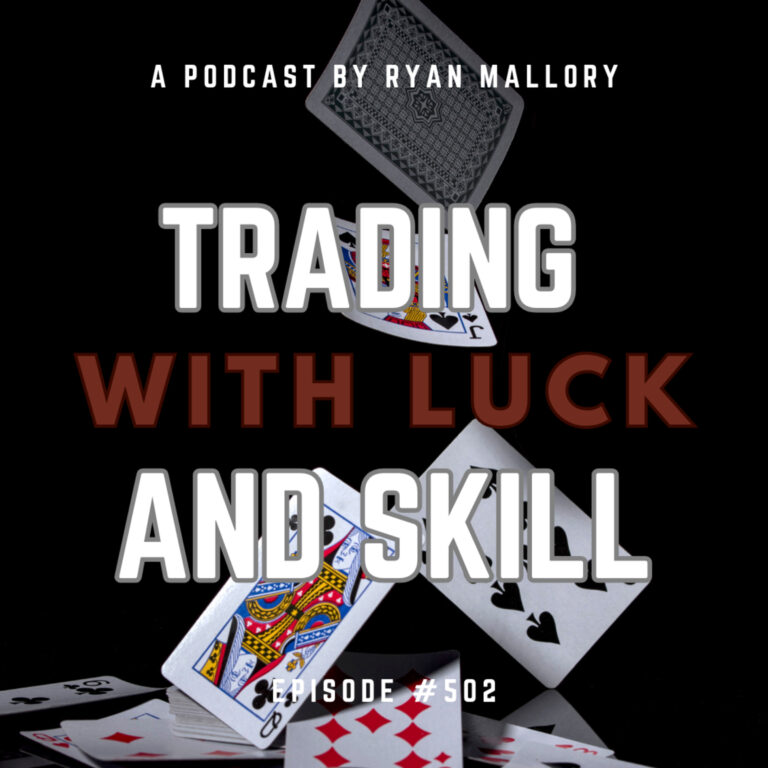Episode Overview
This episode focuses on Ryan’s sector analysis and what he’s looking for when determining which sectors to trade from.
Available on: Apple Podcasts | Spotify | Amazon | YouTube
Episode Highlights & Timestamps
- [0:07] Introduction
Ryan kicks off the episode by setting the tone on managing complexity in trading, particularly around sector analysis. - [1:13] Listener Question: Otis from Tasmania
A long-time listener asks Ryan to break down how he evaluates sector and ETF performance without overloading on indicators. - [2:06] The “Why” Behind Sector Analysis
Ryan explains that the ultimate goal of sector analysis is to find the best stocks within the strongest sectors to improve trading odds. - [4:14] Using the StockCharts Quadrant Tool
Ryan introduces a helpful quadrant tool from StockCharts that helps visualize sector positioning relative to the S&P 500. - [5:47] Real-Time Relevance Over Historical Metrics
Ryan stresses focusing on current sector behavior rather than overemphasizing long-term metrics that don’t aid short-term trades.
Key Takeaways from This Episode:
- Keep It Simple: The purpose of sector analysis is to find strong stocks in strong sectors. Don’t let complexity get in the way.
- Use a Top-Down Approach: Identify market direction, then strong sectors, followed by strong industries and finally the right stocks.
- Focus on Price and Volume: These are the most important indicators in any trade setup, especially when evaluating sector strength.
- Sector Trends Matter: Avoid stocks in declining sectors even if the individual chart looks promising.
- Cash Is an Option: In confusing or volatile environments, stepping back and staying in cash can be a powerful strategic move.
Resources & Links Mentioned:
- Swing Trading the Stock Market – Daily market analysis, trade setups, and insights by Ryan Mallory.
- Join the SharePlanner Trading Block – Get real-time trade alerts and community support.

Take the Next Step:
✅ Stay Connected: Subscribe to Ryan’s newsletter to get free access to Ryan’s Swing Trading Resource Library, along with receiving actionable swing trading strategies and risk management tips delivered straight to your inbox.
📈 Level Up Your Trading: Ready for structured training? Enroll in Ryan’s Swing Trading Mastery Course, The Self-Made Trader, and get the complete trading course, from the foundational elements of trading to advanced setups and profitable strategies.
📲 Join the Trading Community: Sign up for SharePlanner’s Trading Block to become part of Ryan’s swing-trading community, which includes all of Ryan’s real-time swing trades and live market analysis.
Full Episode Transcript
Click here to read the full transcript
0:07
Hey, I’m Ryan Mallory and this is my Swing Trading the Stock Market podcast. I’m here to teach you how to trade in a complex, ever changing world of finance.
0:16
Learn what it means to trade profitably and consistently, managing risk, avoiding the pitfalls of trading, and most importantly, to let those winners run wild.
0:25
You can succeed at the stock market, and I’m ready to show you how. Hey everybody, this is Ryan Mallory with Swing Trading the Stock Market.
0:33
And today we’re gonna talk about doing what you can do to not overcomplicate sector analysis. And this e-mail today that I got comes from a guy, we’ll call him Otis for his Florida redneck name, because I don’t give people’s real names out just in case it this podcast is out there a lot longer than they prefer their name to be out there.
0:47
So I always give people a fake name. So Otis writes.
0:58
Hey Ryan, hope you’re doing well. This is your long time podcast listener French Canadian living in Tasmania, Australia.
1:07
Thank you for doing an episode on my last e-mail. I have another topic that I was hoping that you could provide some insight on.
1:13
What are the actual variables or workflow that you use to look at ETS to identify industry and sector strength weakness and to identify when they may be going through a rotation.
1:22
I feel like I am over complicating my workflow by looking at too many different variables. For example, looking at things like absolute strength over a period of time 136 and 12 months,
1:32
relative strength over a time period 136 and 12 months pattern setting up on the ETF chart, relative strength line or score versus SPY on the benchmark strength and weakness of weekly closing bars,
1:44
relative volume etcetera. Any help in improving my workflow would be greatly appreciated.
1:50
Thanks for all the great insight that you provide. Sincerely, Otis.
1:54
OK, Otis, I got lost a little bit in that e-mail there with all the different things that he’s tracking relative to sector analysis.
2:01
I would say this, boil it down to this. What and why?
2:06
Let’s just focus on the why. Why do I do sector analysis on the stock market?
2:13
Why do I pay attention to it? Why do I even care about it?
2:15
Why do I evaluate it? And that simple answer is, is to get the best stocks within the best industries and sectors, which
2:23
thereby increases my odds for success in trading. I’m not usually trading the individual sectors, Sometimes I will if there’s a really good set up
2:31
there. But most of the time I’m just using it as a benchmark for determining which areas of the stock
2:36
market I want to be trading in, because you can have a strong market, but doesn’t necessarily mean all the sectors are participating in it.
2:44
In fact, until November, the market overall was up on the year, but there was only three sectors that were trading higher on the year.
2:49
The other eight were all trading lower, and right now you still have two sectors that have not broken even yet on the earth.
2:56
For instance, if you got into energy, you’re hurting in the energy front. Energy is not positive on the year, but if you were of the belief that the market was going up, but
3:05
you weren’t really caring too much about what sectors were gonna go up as well, and you held that trade from January 1st up until now, you haven’t made any money in doing so.
3:13
So sector analysis is important. It’s very important.
3:15
But what I’m concerned about here with Otis is that he is way over complicating sector analysis. And by the fact that he’s writing me about it, I think he gets it too.
3:23
He realizes that he’s overcomplicating it. His workflow is very intense and maybe he’s smart enough to be able to handle all that stuff.
3:30
For me personally, it would overwhelm me. I don’t need that much going on when I’m doing the sector analysis.
3:35
So it goes back to why are we doing it, Why are we evaluating it 1 To get the best stocks within the best sectors and to increase our odds for success.
3:43
If anything that we’re doing is not directly leading us to that end, then don’t do it. It makes zero sense to do it.
3:50
And it all goes back to a top down trading strategy that I use. And all my trades I want to get the best stocks to trade that are within the best industries and
4:00
those industries are in the best sectors and those sectors are reflective of the direction of the overall market.
4:05
And in my case, it’s usually SPY and QQQ. One of the things too is I have a tool that I use within stockcharts.com and within that tool you
4:14
have like a quadrant, you have leading, lagging, improving and weakening. So in the top right corner you have leading and the top left you have improving and the bottom left
4:24
you have lagging and in the bottom right you have weakening. So obviously lagging and leading are the two strongest and weakest categories and improving means
4:32
you’re getting closer and closer to leading and weakening means you’re getting closer and closer to lagging.
4:37
And I like to follow the different sectors within those quadrants relative to the S&P 500. Now if you’re in the lagging category doesn’t necessarily mean that you’re not going higher with the
4:47
market. It just means that you’re not going as high as the other sectors are going or as high as the market in general.
4:52
And the sectors that I track are the spiders, ETFs, that’s gonna be XLB that for materials, XLC for communications, XLE for energy and XLF for financials and XLI for industrials, XLV for healthcare, XLP for staples, XLRE for real estate, XLK for technology, XLU for utilities.
5:18
Maybe leaving one or two out. I think I got out a good chunk of them, right?
5:24
XLP? Yeah, I think I got them all.
5:27
So I’m following those 11 sectors and those 11 sectors, I’m gonna focus on the ones that are doing the best.
5:32
So that requires me to do technical analysis on the charts. Now he’s talking about looking at things from 136 and 12 month periods of relative strength.
5:41
Look, most of my charts, most of my trades, I should say, are going to last one to three weeks. That’s about the average.
5:47
Yes, I can get one that lasts a couple of months. If it happens, that’s great.
5:50
It usually means it’s a great winner. But when it comes to sector analysis, when I’m getting into it, I really care about what the sectors
5:57
are doing right now. I don’t care if they were bullish 3 weeks ago and now they’re starting to struggle.
6:02
No, I want be getting into something that’s gonna be bullish right away. Why?
6:06
Because if it’s not bullish right away and I’m getting into a stock with a 3% stop loss, there’s a good chance that I’m gonna be stopped out fairly quickly.
6:12
And I really don’t like being stopped out. Now, that doesn’t mean that I only base my technical analysis off of what I’ve seen over the last
6:18
few weeks. I mean, I could be trading a stock that’s pulled back to a rising trend line that goes back three
6:22
years. And in that case, if it’s gonna bounce off of that rising trend line that goes back three years, I’m
6:27
fine with that. But when it comes to sector analysis, I wanna make sure that the stocks that I’m getting into in
6:33
their respective sectors, that the sectors are actually bouncing or that they’re taking off or that they’re going in the direction that I’m trading.
6:41
In the case of shorting, I want them to be pointing lower. And when I’m also looking at the sectors, I’m also being very cognizant about how overbought and
6:48
oversold they are. Because if the sector starts to get overbought, that could weigh even if like for instance, if I’m
6:53
getting into Goldman Sachs or Citigroup and the stock looks great, great setups, not overbought at all.
7:00
So then if the sector starts to pull back, that could have a huge influence on the individual banking stock that I get into.
7:09
So I want to be cognizant of the oversold, overbought levels. I want to be cognizant of the fact of, you know, what kind of support levels it’s bouncing off of.
7:16
But I also want to make sure that it’s trending in the right direction because I don’t want to get into a stock that has a great setup.
7:23
But the whole sector has just been trending lower and lower and lower over the last week. Makes no sense to because there’s a good chance that that’s going to affect the actual stock itself
7:32
and probably not make it have the kind of results that I’m seeking after. Also, one thing I would tell you to do is check out swingtradingthestockmarket.com.
7:40
swingtradingthestockmarket.com is a really an incredible service that goes alongside of this podcast. With it, you’re gonna get all my stock market research each and every day.
7:48
That’s going to include my daily watch list, the stocks that I’m looking to trade, plus the weekly bullish and bearish master watch list updates that I send out at the start of each week.
7:56
Plus you’re gonna be getting updates on all the big tech stocks. That’s your meta Apple, Amazon, Netflix, Google, NVIDIA, Microsoft, and Tesla.
8:04
And you’re gonna be getting updates on all of the market indices including PS and P500, the NASDAQ 100 and the Russell 2000.
8:12
So check that out. swingtradingthestockmarket.com and you’re supporting the podcast in the process.
8:17
And now the other thing I would probably say to Otis here, and if he’s this over complicated on just a sector analysis, it’d probably be a good thing to go and look at how much complication there is in
8:29
the overall trading as well. Are you doing the same kind of stuff where you’re just inundating yourself with indicators and
8:34
analysis? Because in the end, the more analysis that you get, it’s gonna become harder and harder to find a
8:39
trade that meets any kind of requirement to trade. And also, when you’re making trades, the most important aspects of any trade is price and volume.
8:49
So that should really be the main focus on any analysis, including in sector analysis as well price and volume has to cooperate with your trades.
8:59
Indicators can say all they want. If there isn’t a setup with an edge when you’re looking at price analysis, then that’s probably
9:06
gonna be a difficult trade to succeed on. Now, it doesn’t mean that it can’t succeed.
9:10
When we see stocks all the time, they’re in the middle of a complete freefall and in the on a stop of a dime it reverses and goes right back up.
9:16
It happens. But my trading can’t be based on what I hope that it will do or hope that it could do.
9:21
Yeah, stocks can do anything. But what I want to do is find the best opportunities to succeed the stocks that are setting up with
9:27
the best edge for potential rewards and stay away from the ones that are too much of A mystery to figure out.
9:34
You enjoyed this podcast episode. I would encourage you to leave a five star review on whatever platform you’re listening to.
9:38
Plus check out swingtradingthestockmarket.com and keep sending me your emails ryan@shareplanner.com I do read them all and I do make episodes out of the mall so be sure to send
9:47
them my way. Thank you and God bless.
9:50
Thanks for listening to my podcast Swing Trading the Stock Market. I’d like to encourage you to join me in the SharePlanner or trading block where I navigate the stock
9:57
market each day with traders from around the world. With your membership, you will get a seven day trial and access to in my trading room including
10:05
alerts via text, e-mail and WhatsApp. So go ahead, sign up by going to shareplanner.com/trading Block that’s www.shareplanner.com/trading-block
10:15
and follow me on SharePlanners, Twitter, Instagram and Facebook where I provide unique market and trading information every day.
10:23
If you have any questions, please feel free to e-mail me at ryan@shareplanner.com. All the best to you and I look forward to trading with you soon.
Enjoy this episode? Please leave a 5-star review and share your feedback! It helps others find the podcast and enables Ryan to produce more content that benefits the trading community.
Have a question or story to share? Email Ryan and your experience could be featured in an upcoming episode!
Become part of the Trading Block and get my trades, and learn how I manage them for consistent profits. With your subscription you will get my real-time trade setups via Discord and email, as well as become part of an incredibly helpful and knowledgeable community of traders to grow and learn with. If you’re not sure it is for you, don’t worry, because you get a Free 7-Day Trial. So Sign Up Today!

Welcome to Swing Trading the Stock Market Podcast!
I want you to become a better trader, and you know what? You absolutely can!
Commit these three rules to memory and to your trading:
#1: Manage the RISK ALWAYS!
#2: Keep the Losses Small
#3: Do #1 & #2 and the profits will take care of themselves.
That’s right, successful swing-trading is about managing the risk, and with Swing Trading the Stock Market podcast, I encourage you to email me (ryan@shareplanner.com) your questions, and there’s a good chance I’ll make a future podcast out of your stock market related question.
Is it better to be lucky or skillful when it comes to being a good trader? I would argue you can have it both ways, but it requires that skill manages the luck, and at times when luck is simply against you too.
Be sure to check out my Swing-Trading offering through SharePlanner that goes hand-in-hand with my podcast, offering all of the research, charts and technical analysis on the stock market and individual stocks, not to mention my personal watch-lists, reviews and regular updates on the most popular stocks, including the all-important big tech stocks. Check it out now at: https://www.shareplanner.com/premium-plans
📈 START SWING-TRADING WITH ME! 📈
Click here to subscribe: https://shareplanner.com/tradingblock
— — — — — — — — —
💻 STOCK MARKET TRAINING COURSES 💻
Click here for all of my training courses: https://www.shareplanner.com/trading-academy
– The A-Z of the Self-Made Trader –https://www.shareplanner.com/the-a-z-of-the-self-made-trader
– The Winning Watch-List — https://www.shareplanner.com/winning-watchlist
– Patterns to Profits — https://www.shareplanner.com/patterns-to-profits
– Get 1-on-1 Coaching — https://www.shareplanner.com/coaching
— — — — — — — — —
❤️ SUBSCRIBE TO MY YOUTUBE CHANNEL 📺
Click here to subscribe: https://www.youtube.com/shareplanner?sub_confirmation=1
🎧 LISTEN TO MY PODCAST 🎵
Click here to listen to my podcast: https://open.spotify.com/show/5Nn7MhTB9HJSyQ0C6bMKXI
— — — — — — — — —
💰 FREE RESOURCES 💰
— — — — — — — — —
🛠 TOOLS OF THE TRADE 🛠
Software I use (TC2000): https://bit.ly/2HBdnBm
— — — — — — — — —
📱 FOLLOW SHAREPLANNER ON SOCIAL MEDIA 📱
*Disclaimer: Ryan Mallory is not a financial adviser and this podcast is for entertainment purposes only. Consult your financial adviser before making any decisions.





